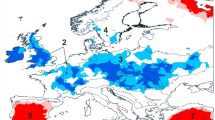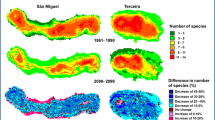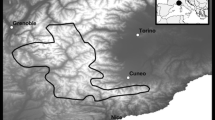Abstract
The Caatinga is a semiarid biome of the northeast of Brazil with only 1 % of its territory currently conserved. The biome’s biodiversity is highly threatened due to exposure to land conversion for agricultural and cattle ranch. Climate forecasts predict increases in aridity, which could pose additional threats to the biome’s biodiversity. Here, we ask if the remnants of natural vegetation in Caatinga biome, where endemic terrestrial vertebrate species occur, are likely to retain more climatic suitability under climate change scenarios than other less pristine areas of the biome. In order to assess changes in climate suitability across individual species ranges, ensemble forecasting was used based on seven bioclimatic envelope models, three atmosphere–ocean general circulation models, and two greenhouse emission gas scenarios for 2020, 2050, and 2080. We found that most species will gain climatic suitability in the natural vegetation remnants of the Caatinga. Such gains are even greater than the expected to occur within random sets of areas with size similar to the natural vegetation remnants. Our results suggest that natural vegetation remnants will likely play a role of climate refuges for endemic vertebrate species, so efforts should be concentrated in these regions.


Similar content being viewed by others
References
Ab’Saber NA (1977) Espaços ocupados pela expansão dos climas secos na América do Sul, por ocasião dos períodos glaciais quaternários (SériePaleoclimas,3). Instituto de Geografia/USP, São Paulo
Alagador D, Martins MJ, Orestes-Cerdeira J, Cabeza M, Araújo MB (2011) A probability-based approach to match species with reserves when data are in different resolutions. Biol Conserv 144:811–820
Andrade-Lima D (1982) Present-day forest refuges in northeastern Brazil. In: Prance GT (ed) Biological diversification in the tropics. Columbia University Press, New York, pp 245–254
Araújo MB (2004) Matching species with reserves—uncertainties from using data at different resolutions. Biol Conserv 118:533–538
Araújo MB, New M (2007) Ensemble forecasting of species distributions. Trends Ecol Evol 22:42–47
Araújo MB, Rahbek C (2007) Conserving biodiversity in a world of conflicts. J Biogeogr 34:199–200
Araújo MB, Williams PH, Turner A (2002) A sequential approach to minimise threats within selected conservation areas. Biodivers Conserv 11:1011–1024
Araújo MB, Thuiller W, Williams PH, Reginster I (2005) Downscaling European species atlas distributions to a finer resolution: implications for conservation planning. Glob Ecol Biogeogr 14:17–30
Araújo MB, Alagador D, Cabeza M, Lafourcade B, Nogués-Bravo D, Thuiller W (2011) Climate change threatens European conservation areas. Ecol Lett 14:484–492
Balmford A, Moore JL, Brooks T, Burgess N, Hansen LA, Williams P, Rahbek C (2001) Conservation conflicts across Africa. Science 291:2616–2619
Bini LM, Diniz-Filho JAF, Rangel TFLVB, Akre TSB, Albaladejo RG, Albuquerque RS, Aparicio A, Araújo MB, Baselga A, Beck J, Belloq MB, Böhning-Gaese K, Borges PAV, Castro-Parga I, Chey VK, Chown SL, De Marco P, Dobkin DS, Ferrer-Castán D, Field R, Filloy J, Fleishman E, Gómez JF, Hortal J, Iverson JB, Kerr JT, Kissling WD, Kitching IJ, León-Cortéz JL, Lobo JM, Montoya D, Morales-Castilla I, Moreno JC, Oberdorff T, Olalla-Tárraga MÁ, Pausas JG, Qian H, Rahbek C, Rodríguez MÁ, Rueda M, Ruggiero A, Sackmann P, Sanders NJ, Terribile LC, Vetaas OR, Hawkins BA (2009) Coefficient shifts in geographical ecology: an empirical evaluation of spatial and non-spatial regression. Ecography 32:193–204
Borcard D, Legendre P (2002) All-scale spatial analysis of ecological data by means of principal coordinates of neighbour matrices. Ecol Model 153:51–68
Breiman L (2001) Random forest. Mach Learn 45:5–32
Buisson L, Thuiller W, Casajus§ N, Lek S, Grenouillet G (2010) Uncertainty in ensemble forecasting of species distributions. Glob Change Biol 16:1145–1157
Busby JR (1991) BIOCLIM: a bioclimate analysis and prediction system. In: Margules CR, Austin MP (eds) Nature conservation: cost effective biological surveys and data analysis. CSIRO, Melbourne, pp 64–68
Cardillo M, Mace GM, Jones KE, Bielby J, Bininda-Emonds ORP, Sechrest W, Orme CDL, Purvis A (2005) Multiple causes of high extinction risk in large mammal species. Science 309:1239–1241
Cardillo M, Mace GM, Gittleman JL, Purvis A (2006) Latent extinction risk and the future battlegrounds of mammal conservation. Proc Natl Acad Sci USA 103:4157–4161
Castelletti CHM, Silva JMC, Tabarelli M, Santos AMM (2004) Quanto ainda resta da Caatinga? Uma estimativa preliminar. In: Silva JMC, Tabarelli M, Lins L (eds) Biodiversidade da Caatinga: áreas e ações prioritárias para a conservação. Ministério do Meio Ambiente, Brasília, pp 92–100
Coimbra-Filho AF, Câmara IG (1996) Os limites originais do bioma Mata Atlântica na região Nordeste do Brasil. Fundação Brasileira para Conservação da Natureza, Rio de Janeiro
Da Costa RC, de Araújo FS, Lima-Verde LW (2007) Flora and life-form spectrum of deciduous thorn woodland (caatinga) in northeastern, Brazil. J Arid Environ 68:237–247
Darhoh MBK (1998) The nature, causes and consequences of desertification in the drylands of Africa. Land Degrad Dev 9:1–20
de Oliveira G, Diniz-Filho JAF (2010) Spatial patterns of terrestrial vertebrates richness in Brazilian semiarid, Northeastern Brazil: selecting hypotheses and revealing constraints. J Arid Environ 74:1418–1426
de Oliveira G, Diniz-Filho JAF (2011) Evaluating environmental and geometrical constraints on endemic vertebrates of the semiarid Caatinga. Basic Appl Ecol 12:664–673
Diniz-Filho JAF, Bini LM (2005) Modelling geographical patterns in species richness using eigenvector-based spatial filters. Global Ecol Biogeogr 14:177–185
Diniz-Filho JAF, Bini LM (2008) Macroecology, global change and the shadow of forgotten ancestors. Global Ecol Biogeogr 17:11–17
Diniz-Filho JAF, Bini LM, Hawkins BA (2003) Spatial autocorrelation and red herrings in geographical ecology. Global Ecol Biogeogr 12:53–64
Diniz-Filho JAF, Bini LM, Rangel TFLVB, Loyola RD, Hof C, Nogués-Bravo D, Araújo MB (2009a) Partitioning and mapping uncertainties in ensemble of forecasts of species turnover under climate change. Ecography 32:897–906
Diniz-Filho JAF, De Oliveira G, Bini LM, Loyola RD, Nabout JC, Rangel TFLVB (2009b) Conservation biogeography and climate change in the Brazilian Cerrado. Nat Conserv 7:100–112
Diniz-Filho JAF, de Marco P, Hawkins BA (2010) Defying the course of ignorance: perspectives in insect macroecology and conservation biology. Insect Conserv Divers 3:172–179
Dormann CF, Mcpherson J, Araújo MB, Bivand R, Bolliger J, Carl G, Davies RG, Hirzel A, Jetz W, Kissling WD, Kühn I, Ohlemüller R, Peres-Neto P, Reineking B, Schröder B, Schurr FM, Wilson R (2007) Methods to account for spatial autocorrelation in the analysis of distributional species data: a review. Ecography 30:609–628
Eisenberg JF, Redford KH (1999) Mammals of neotropics. The University of Chicago Press, Chicago\London
Ellis EC, Ramankutty N (2008) Putting people in the map: anthropogenic biomes of the world. Front Ecol Environ 6:439–447
Engler R, Randin CF, Thuiller W, Dullinger S, Zimmermann NE, Araújo MB, Pearman PB, Lay G, Piedallu C, Albert CH, Choler P, Coldea G, de Lamo X, Dirnböck T, Gégout J, Gómez-Garcia D, Grytnes J, Heegaard E, Høistad F, Nogués-Bravo D, Normand S, Puşcaş M, Sebastià M, Stanisci A, Theurillat J, Trivedi MR, Vittoz P, Guisan A (2011) 21st century climate change threatens mountain flora unequally across Europe. Glob Change Biol 17:2330–2341
Farber O, Kadmon R (2003) Assessment of alternative approaches for bioclimatic modelling with special emphasis on the Mahalanobis distance. Ecol Model 160:115–130
Garcia RA, Burgess ND, Cabeza M, Rahbek C, Araújo MB (2012) Exploring consensus in 21st century projections of climatically suitable areas for African vertebrates. Glob Change Biol 18:1253–1269
Geist HJ, Lambin EF (2004) Dynamic causal pattern of desertification. Bioscience 54:817–830
Griffith DA (2003) Spatial autocorrelation and spatial filtering—gaining understanding through theory and scientific visualization. Springer, Berlin
Griffith DA, Peres-Neto PR (2006) Spatial modeling in ecology: the flexibility of eigenfunction spatial analysis. Ecology 87:2603–2613
Hawkins BA, Rodríguez MÁ, Weller SG (2011) Global angiosperm family richness revisited: linking ecology and evolution to climate. J Biogeogr 38:1253–1266
Hijmans RJ, Cameron SE, Parra JL, Jones PG, Jarvis A (2005) Very high resolution interpolated climate surfaces for global land areas. J Climatol 25:1965–1978
IPCC (Intergovernmental Panel on Climate Change) (2000) A special report of IPCC working group III
IUCN (2011) IUCN red list of threatened species. Version 2010.1. www.iucnredlist.org. Accessed 15 June 2011
Kleinbauer I, Dullinger S, Peterseil J, Essl F (2010) Climate change might drive the invasive tree Robinia pseudacacia into nature reserves and endangered habitats. Biol Conserv 143:382–390
Leal IR, Tabarelli M, Silva JMC (2003) Ecologia e conservação da Caatinga. Editora Universitária, Recife
Leal IR, Silva JMC, Tabarelli M, Lacher TE Jr (2005) Changing the course of biodiversity conservation in the Caatinga of Northeastern Brazil. Conserv Biol 19:701–706
Legendre P (1993) Spatial autocorrelation—trouble or new paradigm. Ecology 74:1659–1673
Luck GW (2007) A review of relationships between human population density and biodiversity. Biol Rev 82:607–645
Malhado ACM, Pires GF, Costa MH (2010) Cerrado conservation is essential to protect the Amazon rainforest. Ambio 39:580–584
Mamede MA, Araújo FS (2008) Effects of slash and burn practices on a soil seed bank of Caatinga vegetation in Northeast Brazil. J Arid Environ 72:458–470
Margules CR, Pressey RL (2000) Systematic conservation planning. Nature 405:243–253
Marinho-Filho J, Veríssimo EW (1997) The rediscovery of Callicebus personatus barbarabrownae in Northeastern Brazil with a new Western limit for its distribution. Primates 38:429–433
Marini MÂ, Barbet-Massin M, Lopes LE, Jiguet F (2009) Major current and future gaps of Brazilian reserves to protect Neotropical savanna birds. Biol Conserv 142:3039–3050
McCullagh P, Nelder JÁ (1989) Generalized linear models. Chapman and Hall, Boca Raton
Pereira IM, Andrade LA, Sampaio EVSB, Barbosa MRV (2003) Use-history effects on structure and flora of Caatinga. Biotropica 35:154–165
Peterson AT, Soberon J, Pearson RG, Anderson RP, Martinez-Meyer ER, Nakamura M, Araújo MB (2011) Ecological niches and geographical distributions, monographs in population biology, vol 49. Princeton University Press, Princeton
Phillips SJ, Abderson RP, Schapire RE (2006) Maximum entropy modelling of species geographic distributions. Ecol Model 190:231–259
Prance GT (1987) Vegetation. In: Whitmore TC, Prance GT (eds) Biogeography and quaternary history in tropical America. Oxford Science Publications, Oxford
R Development Core Team (2009) R: a language and environment for statistical computing. R Foundation for Statistical Computing, Vienna. Available from http://www.r-project.org
Rangel TFLVB, Diniz-Filho JAF, Bini LM (2006) Towards an integrated computational tool for spatial analysis in macroecology and biogeography. Global Ecol Biogeogr 15:321–327
Rangel TFLVB, Diniz-Filho JAF, Bini LM (2010) SAM: a comprehensive application for spatial analysis in macroecology. Ecography 33:46–50
Rodrigues MT (1996) Lizards, snakes, and amphisbaenians from the quaternary sand dunes of the middle Rio Sao Francisco, Bahia, Brazil. J Herpetol 30:513–526
Rodrigues MT (2003) Herpetofauna da Caatinga. In: Leal IR, Tabarelli M, Silva JMC (eds) Ecologia e conservação da Caatinga. Editora Universitária, Recife, pp 181–236
Salazar LF, Nobre CA, Oyama MD (2007) Climate change consequences on the biome distribution in tropical South America. Geophys Res Lett 34:1–16
Sampaio EVSB (1995) Overview of the Brazilian Caatinga. In: Bullock SH, Mooney HA, Medina E (eds) Seasonally tropical dry forests. Cambridge University Press, Cambridge, pp 35–63
Silva VPR (2004) On climate variability in Northeast Brazil. J Arid Environ 58:575–596
Sivakumar MKV (2007) Interactions between climate and desertification. Agric Forest Meteorol 142:143–155
Stockwell DRB, Noble IR (1992) Inductions of sets of rules from animal distribution data: a robust and informative method of data analysis. Math Comput Simul 33:385–390
Thomas CD (2010) Climate, climate change and range boundaries. Divers Distrib 16:488–495
Thuiller W, Lafourcade B, Engler R, Araújo MB (2010) BIOMOD 2009—a platform for ensemble forecasting of species distributions. Ecography 32:369–373
Vanzolini PE, Ramos-Costa AMM, Vitt LJ (1980) Répteis das Caatingas. Academia Brasileira de Ciências, Rio de Janeiro
Veloso HP, Rangel-Filho ALR, Lima JCA (1991) Classificação da vegetação brasileira, adaptada a um sistema universal. IBGE-Departamento de Recursos Naturais e Estudos Ambientais, Rio de Janeiro
Vieira WLS, Santana GD, Arzabe C (2009) Diversity of reproductive modes in anuran communities in the Caatinga drylands of northeastern Brazil. Biodivers Conserv 18:55–66
Whittaker RJ, Araújo MB, Jepson P, Ladle RJ, Watson JEM, Willis KJ (2005) Conservation biogeography: assessment and prospect. Divers Distrib 11:3–23
Williams PH, Hannah L, Andelman S, Midgley GF, Araújo MB, Hughes G, Manne L, Martinez-Meyer E, Pearson R (2005) Planning for climate change: identifying minimum-dispersal corridors for the Cape Proteaceae. Conserv Biol 19:1063–1074
Acknowledgments
The authors are grateful to two anonymous reviewers, and to the cooperation project of Fundação para Ciência e a Tecnologia and Coordenação de Aperfeiçoamento de Pessoal de Nível Superior (FCT-CAPES, Portugal–Brasil). GO is supported by Conselho Nacional de Desenvolvimento Científico e Tecnológico (CNPq) doctoral fellowship (Proc. No. 552961/2008-6), and work by TFR and JAFDF on climate change and BEMs have been continuously supported by CNPq productivity grants and by the “Rede Nacional de Mudanças Climáticas” of INPE. GO was sponsored by CAPES-Balcão (Proc. No. 5201-09-8) while visiting the Universidade de Évora, Rui Nabeiro Biodiversity Chair, Portugal. DA was supported by a postdoctoral studentship (SFRH/BPD/51512/2011) awarded by FCT. Research by MBA, JAFDF, and TLFVBR is supported by the FCT Range Shift project.
Author information
Authors and Affiliations
Corresponding author
Electronic supplementary material
Below is the link to the electronic supplementary material.
Rights and permissions
About this article
Cite this article
de Oliveira, G., Araújo, M.B., Rangel, T.F. et al. Conserving the Brazilian semiarid (Caatinga) biome under climate change. Biodivers Conserv 21, 2913–2926 (2012). https://doi.org/10.1007/s10531-012-0346-7
Received:
Accepted:
Published:
Issue Date:
DOI: https://doi.org/10.1007/s10531-012-0346-7




